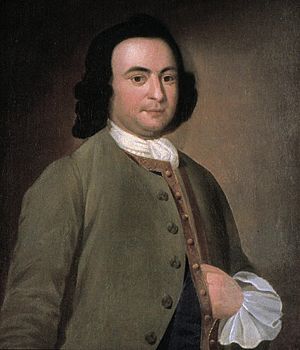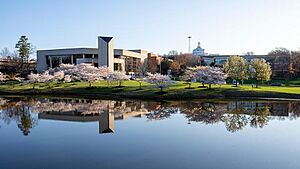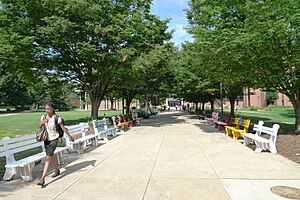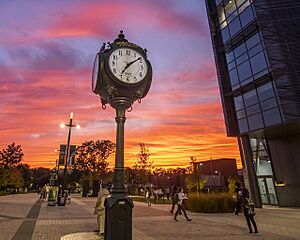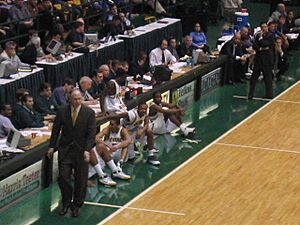George Mason University facts for kids
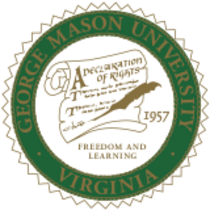
Seal of George Mason University
|
|
|
Former names
|
Northern Virginia University Center of the University of Virginia (1949–1956) University College of the University of Virginia (1956–1959) George Mason College of the University of Virginia (1959–1972) |
|---|---|
| Motto | "Freedom and Learning" |
| Type | Public research university |
| Established | 1949 |
| Founder | University of Virginia (original charter) Virginia General Assembly (as independent university) |
| Accreditation | SACS |
|
Academic affiliations
|
|
| Endowment | $189.2 million (2021) |
| President | Gregory Washington |
| Provost | Kenneth Walsh (interim) |
| Rector | Horace Blackman |
|
Academic staff
|
2,133 (fall 2023) |
| Students | 40,185 (fall 2023) |
| Undergraduates | 27,160 (fall 2023) |
| Postgraduates | 11,804 (fall 2023) |
| Location |
,
,
United States
38°49′52″N 77°18′29″W / 38.831°N 77.308°W |
| Campus | Large Suburb, 953 acres (386 ha) (Fairfax), 1,148 acres (465 ha) total |
| Location of Campuses | United States: South Korea: |
| Media | Fourth Estate (newspaper) WGMU Radio (radio station) |
| Colors | Green Gold |
| Nickname | Patriots |
|
Sporting affiliations
|
|
| Mascot | The Patriot |
 |
|
George Mason University (GMU) is a public research university in Fairfax County, Virginia, in Northern Virginia, near Washington, D.C. The university is named in honor of George Mason, a Founding Father of the United States.
The university was founded in 1949, and it became an independent university in 1972. The school has since grown into the largest public university by student enrollment in Virginia. The university is classified among "R1: Doctoral Universities – Very high research activity."
Originally founded as a branch of the University of Virginia, the university has since expanded into a residential college for traditional students with an emphasis on combining modern practice-based professional education with a comprehensive traditional liberal arts curriculum while maintaining its historic commuter student-inclusive environment at both undergraduate and post-graduate levels. The university operates four campuses in Virginia.
The university's flagship campus is in Fairfax, Virginia. Its other three campuses are in Arlington, Front Royal, and Prince William County. It also operates a retreat and conference center in Lorton and an international campus in Incheon, South Korea.
Since the university's founding, two of its economics professors, James M. Buchanan in 1986 and Vernon L. Smith in 2002, have been awarded the Nobel Memorial Prize in Economics.
Contents
History
20th century
In 1949, the University of Virginia created an extension center to serve mid-career working professionals and non-traditional students near urban centers in the Northern Virginia suburbs of Washington, D.C. The extension center offered both for credit and non-credit informal classes in the evenings at various pre-existing venues. The first for credit classes offered were: "Government in the Far East, Introduction to International Politics, English Composition, Principles of Economics, Mathematical Analysis, Introduction to Mathematical Statistics, and Principles of Lip Reading." By the end of 1952, enrollment was 1,192 students.
A resolution of the Virginia General Assembly in January 1956 changed the extension center into University College, the Northern Virginia branch of the University of Virginia. John Norville Gibson Finley served as director. Seventeen freshmen students attended classes at University College in a small renovated elementary school building in Bailey's Crossroads starting in September 1957. In 1958 University College became George Mason College.
The City of Fairfax purchased and donated 150 acres (60 hectares) of land just south of the city limits to the University of Virginia for the college's new site, which is now referred to as the Fairfax Campus. In 1959, the Board of Visitors of the University of Virginia selected a permanent name for the college: George Mason College of the University of Virginia. The Fairfax campus construction planning that began in early 1960 showed visible results when the development of the first 40 acres (16 hectares) of Fairfax Campus began in 1962. In the Fall of 1964 the new campus welcomed 356 students.
In 1966, in the Virginia General Assembly, Alexandria delegate James M. Thomson, with the backing of the University of Virginia, introduced a bill in the General Assembly to make George Mason College a four-year institution under the University of Virginia's direction. The measure, known as H 33, passed the Assembly easily and was approved on March 1, 1966, making George Mason College a degree-granting institution. During that same year, the local jurisdictions of Fairfax County, Arlington County, and the cities of Alexandria and Falls Church agreed to appropriate $3 million to purchase land adjacent to Mason to provide for a 600-acre (240-hectare) Fairfax Campus with the intention that the institution would expand into a regional university of major proportions, including the granting of graduate degrees.
In 1972, Virginia separated George Mason College from the University of Virginia in Charlottesville and renamed it George Mason University.
In 1978, George W. Johnson was appointed to serve as the fourth president. Under his eighteen-year tenure, the university expanded both its physical size and program offerings at a tremendous rate. Shortly before Johnson's inauguration in April 1979, Mason acquired the School of Law and the new Arlington Campus. The university also became a doctoral institution. Toward the end of Johnson's term, Mason would be deep in planning for a third campus in Prince William County at Manassas. Major campus facilities, such as Student Union Building II, EagleBank Arena, Center for the Arts, and the Johnson Learning Center, were all constructed over the course of Johnson's eighteen years as University President. Enrollment once again more than doubled from 10,767 during the fall of 1978 to 24,368 in the spring of 1996.
In 1996, Alan Merten, dean of the Samuel Curtis Johnson Graduate School of Management at Cornell University was appointed the university's president. He believed that the university's location made it responsible for both contributing to and drawing from its surrounding communities—local, national, and global. George Mason was becoming recognized and acclaimed in all of these spheres. During Merten's tenure, the university hosted the World Congress of Information Technology in 1998, celebrated a second Nobel Memorial Prize-winning faculty member in 2002, and cheered the Men's basketball team in their NCAA Final Four appearance in 2006. Enrollment increased from just over 24,000 students in 1996 to approximately 33,000 during the spring semester of 2012, making Mason Virginia's largest public university.
21st century
Following Merten's retirement in 2012, Ángel Cabrera was appointed the university's sixth president on July 1, 2012.
In a resolution on August 17, 2012, the board asked Cabrera to create a new strategic vision that would help Mason remain relevant and competitive in the future. The drafting of the Vision for Mason, from conception to official outline, created a new mission statement that defines the university.
On March 25, 2013, Cabrera held a press conference to announce the university's decision to leave the Colonial Athletic Association to join the Atlantic 10 Conference (A-10). The announcement came just days after the Board of Visitors' approval of the university's vision document that Cabrera had overseen. Mason began competition in the A-10 during the 2013–2014 academic year. The Chronicle of Higher Education listed Mason as one of the "Great Colleges to Work For" from 2010 to 2014. The Washington Post listed Mason as one of the "Top Workplaces" in 2014.
The WorldatWork Alliance for Work-Life Progress awarded Mason the Seal of Distinction in 2015. The AARP listed Mason as one of the Best Employers for Workers Over 50 in 2013. Phi Beta Kappa established a chapter at the university in 2013.
In 2018, a Freedom of Information Act lawsuit revealed that conservative donors, including the Charles Koch Foundation and Federalist Society, were given direct influence over faculty hiring decisions at the university's law and economics schools. GMU President Ángel Cabrera acknowledged that the revelations raised questions about the university's academic integrity and pledged to prohibit donors from sitting on faculty selection committees in the future.
Cabrera resigned his position on July 31, 2019, to become president of Georgia Tech. Following Cabrera's resignation, Anne B. Holton served as interim president until June 30, 2020.
On February 24, 2020, the Board of Visitors appointed Gregory Washington as the university's eighth president, and he assumed that role on July 1, 2020. Washington is the university's first African-American president.
On March 23, 2020, George Mason shifted to exclusively online instruction during the COVID-19 pandemic. Hybrid instruction occurred during the Fall 2020, Spring 2021, and Fall 2021 semesters during which the university offered a combination of online and in-person instruction.
Campuses
George Mason University has four campuses in the United States, each of which is located in Virginia. Three are in the Northern Virginia suburbs of the Washington metropolitan area, and one is in Virginia's Blue Ridge Mountains. The university also has one campus in South Korea, in the Songdo International Business District of Incheon. Between 2005 and 2009 the university had a campus at Ras al-Khaimah, United Arab Emirates. The Blue Ridge campus, just outside Front Royal, is run in cooperation with the Smithsonian Institution.
Fairfax
The university's flagship Fairfax Campus is situated on 677 acres (274 hectares) of landscaped land with a large pond in a suburban environment in George Mason, Virginia, just south of the City of Fairfax in central Fairfax County. The national capital of Washington, D.C. is approximately 20 miles (32 km) from campus. Notable buildings include the 320,000-square-foot (30,000 m2) student union building, the Johnson Center; the Center for the Arts, a 2,000-seat concert hall; the 180,000-square-foot (17,000 m2) Long and Kimmy Nguyen Engineering Building; Exploratory Hall for science, new in 2013; an astronomy observatory and telescope; the 88,900-square-foot (8,260 m2) Art and Design Building; the newly expanded Fenwick Library, the Krasnow Institute; and three fully appointed gyms and an aquatic center for student use. The stadiums for indoor and outdoor track and field, baseball, softball, tennis, soccer and lacrosse are also on the Fairfax campus, as is Masonvale, a housing community for faculty, staff and graduate students.
George Mason statue and Enslaved People of George Mason Memorial
The bronze statue of George Mason on campus was created by Wendy M. Ross and dedicated on April 12, 1996. The 712 foot statue shows George Mason presenting his first draft of the Virginia Declaration of Rights which was later the basis for the U.S. Constitution's Bill of Rights. Beside Mason is a model of a writing table that is still in the study of Gunston Hall, Mason's Virginia estate. The books on the table, volumes of Hume, Locke ,and Rousseau, represent influences in his thought.
In 2021, an Enslaved People of George Mason Monument designed by Perkins & Will was installed near the George Mason Statue. The memorial includes panels describing the lives of two of the enslaved at Gunston Hall: Penny, who was gifted by Mason to his daughter, and James, Mason’s personal attendant.
Arlington
The Arlington Campus, named Mason Square in 2022, is situated on 5.2 acres (2.1 hectares) in Virginia Square, an urban environment on the edge of Arlington County, Virginia's Clarendon business district and four miles (6.4 km) from downtown Washington, D.C. The campus was founded in 1979 with the acquisition of a law school. In 1998, Hazel Hall opened to house the Antonin Scalia Law School; subsequent development created Van Metre Hall (formerly Founders Hall), home of the Schar School of Policy and Government, the Center for Regional Analysis, and the graduate-level administrative offices for the School of Business. Vernon Smith Hall houses the Jimmy and Rosalynn Carter School for Peace and Conflict Resolution, the Mercatus Center, and the Institute for Humane Studies. The campus also houses the 300-seat Van Metre Hall Auditorium. A new building, Fuse at Mason Square, is scheduled to be completed in 2025.
Transportation

The campus is served by the Washington Metro's Orange Line at the Virginia Square–GMU station, a campus shuttle service, and Metrobus route 38B. The rail station is located one block west of the campus. Arlington Rapid Transit or ART Bus routes 41, 42, and 75 also provide service at this location. The campus offers one electric vehicle charging station, five disabled permit automotive parking locations, three bicycle parking locations, and one Capital Bikeshare location.
Science and Technology campus
The Science and Technology campus opened on August 25, 1997, as the Prince William campus in Manassas, Virginia, on 134 acres (54 hectares) of land, some still currently undeveloped. More than 4,000 students are enrolled in classes in bioinformatics, biotechnology, information technology, and forensic biosciences educational and research programs. There are undergraduate programs in health, fitness and recreation. There are graduate programs in exercise, fitness, health, geographic information systems, and facility management. Much of the research takes place in the high-security Biomedical Research Laboratory. The 1,123-seat Merchant Hall and the 300-seat Verizon Auditorium in the Hylton Performing Arts Center opened in 2010.
The 110,000-square-foot Freedom Aquatic and Fitness Center is operated by the Mason Enterprise Center. The Mason Center for Team and Organizational Learning stylized as EDGE is an experiential education facility open to the public. The Sports Medicine Assessment Research and Testing lab stylized as SMART Lab is located within the Freedom center. The SMART Lab is most known for its concussion research. On April 23, 2015, the campus was renamed to the Science and Technology Campus.
In 2019, the university engaged in a feasibility study of creating a medical school at the Prince William Campus.
Smithsonian-Mason School of Conservation
The campus in Front Royal, Virginia, is a collaboration between the Smithsonian Institution and the university. Open to students in August 2012 after breaking ground on the project on June 29, 2011, the primary focus of the campus is global conservation training. The Volgenau Academic Center includes three teaching laboratories, four classrooms, and 18 offices. Shenandoah National Park is visible from the dining facility's indoor and outdoor seating. Living quarters include 60 double occupancy rooms, an exercise facility, and study space.
Mason Korea
|
Mason Korea
Korea Campus
|
|
|---|---|
| Songdo Campus Hangul: 송도 캠퍼스 |
|
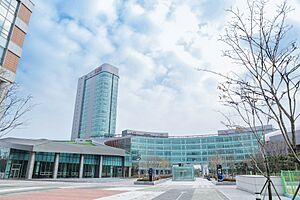
Data Center, Library, Guest House, Student's Hall
|
|
| Country | |
| Region | Seoul Capital Area (Sudogwon) |
| Metropolitan City | |
| District | Yeonsu-gu |
| International Business District | Songdo |
| Postal Code |
21985
|
Opened in March 2014, Mason Korea is located in the Songdo International Business District in South Korea, a 42,000-acre (17,000-hectare) site designed for 850,000 people. It is located 25 miles (40 km) from Seoul and a two-hour flight from China and Japan, and is connected to the Seoul Metropolitan Subway.
The Commonwealth of Virginia considers the Songdo campus legally no different from any other Mason campus:
"... board of visitors shall have the same powers with respect to operation and governance of its branch campus in Korea as are vested in the board by the Code of Virginia with respect to George Mason University in Virginia ..."
Mason Korea's first commencement class graduated in December 2017.
Students from Mason Korea earn the same diploma as home campus students, with English as the language of instruction.
Academics
Rankings
| ARWU World | 201–300 |
|---|---|
| THES World | 401–500 |
| USNWR National University | 105 |
| Washington Monthly National University | 61 |
| Forbes | 91 |
Mason offers undergraduate, graduate master's, law, and doctoral degrees with an emphasis on combining modern practice-based professional education with a comprehensive traditional liberal arts curriculum. The student-faculty ratio is 17:1; 58 percent of undergraduate classes have fewer than 30 students and 30 percent of undergraduate classes have fewer than 20 students.
Admissions
In 2023, the university accepted 90% of its undergraduate applicants, and did not consider high school class rank or require standardized test scores for admission. For those submitting scores the middle 50% had an SAT score between 1140 and 1350 or an ACT score between 25 and 31.
Between 2009 and 2013, George Mason saw a 21% increase in the number of applications, has enrolled 4% more new degree-seeking students, and has seen the percentage of undergraduate and graduate applications accepted each decrease by 4%. Law applications accepted increased by 10%. Mason enrolled 33,917 students for fall 2013, up 956 (+3%) from fall 2012. Undergraduate students made up 65% (21,990) of the fall enrollment, graduate students 34% (11,399), and law students 2% (528). Undergraduate headcount was 1,337 higher than fall 2012 (+7%); graduate headcount was 262 lower (−2%); and law student headcount was 119 lower (−18%). Matriculated students come from all 50 states and 122 foreign countries. As of fall 2014, the university had 33,791 students enrolled, including 21,672 undergraduates, 7,022 seeking master's degrees, 2,264 seeking doctoral degrees and 493 seeking law degrees.
Enrollment
As of 2023, the university enrolled 40,185 students, making it the largest university by head count in Virginia.
Academic affiliations
- Consortium of Universities of the Washington Metropolitan Area (CUWMA)
- National Sea Grant College Program (Sea-grant)
- Oak Ridge Associated Universities (ORAU)
- Smithsonian Institution (SI) - Smithsonian Conservation Biology Institute (SCBI)
- State Council of Higher Education for Virginia (SCHEV)
- Transatlantic Policy Consortium (TPC)
- Washington Research Library Consortium (WRLC)
Research
George Mason University hosts $149 million in sponsored research projects annually, as of 2019. In 2016, Mason was classified among "R1: Doctoral Universities – Very high research activity". Mason moved into this classification based on a review of its 2013–2014 data that was performed by the Center for Postsecondary Research at Indiana University.
The research is focused on health, sustainability and security. In health, researchers focus is on wellness, disease prevention, advanced diagnostics and biomedical analytics. Sustainability research examines climate change, natural disaster forecasting, and risk assessment. Mason's security experts study domestic and international security as well as cyber security.
Centers and institutes
The university is home to numerous research centers and institutes.
- Center for Applied Proteomics and Molecular Medicine
- Center for Clean Water and Sustainable Technologies (CCWST)
- Center for Climate Change Communication (4C)
- Center for Collision Safety and Analysis
- Center for Excellence in Command, Control, Communications, Computing and Intelligence (C4I)
- Center for Humanities Research
- Center for Location Science
- Center for Neural Informatics
- Center for Peacemaking Practice
- Center for Real Estate Entrepreneurship
- Center for Regional Analysis
- Center for Social Complexity
- Center for Study of Public Choice
- Center for Neural Informatics, Structures, and Plasticity (CN3)
- Center for Well-Being
- Institute for Advanced Biomedical Research
- Interdisciplinary Center for Economic Science
- Krasnow Institute for Advanced Study
- Mercatus Center
- National Center for Biodefense and Infectious Diseases
- Roy Rosenzweig Center for History and New Media
- SMART Lab (Sports Medicine Assessment, Research & Testing)
- Stephen S. Fuller Institute
- Michael V. Hayden Center for Intelligence, Policy, and International Security
- Center for Security Policy Studies
- Center for Transportation Public-Private Partnership Policy
- Center on Nonprofits, Philanthropy, and Social Enterprise
- Terrorism, Transnational Crime and Corruption Center (TraCCC)
- Center for Energy Science and Policy
- National Security Institute
- Center for Government Contracting
- Global Antitrust Institute
- Center for World Religions, Diplomacy and Conflict Resolution
- Center for the Study of Gender and Conflict Resolution
- Peace and Conflict Studies Center Asia (PACSC Asia)
- Center for the Study of Narrative and Conflict Resolution
- Mary Hoch Center for Reconciliation
Student life and community relations
Traditions
Students have often decorated the George Mason statue on the Fairfax campus for events. Some have rubbed the statue toe to bring good luck. Many pose with the statue for graduation photographs. Between 1988 and 1990 Anthony Maiello wrote the original George Mason Fight Song, which was edited by Michael Nickens in 2009.
Each spring, student organizations at Mason compete to paint one of the 38 benches located on the Quad in front of Fenwick Library. For years, student organizations have painted those benches that line the walkway to gain recognition for their group. With more than 300 student organizations, there is much competition to paint one of the benches. Painting takes place in the spring.
Housing
On the Fairfax campus, the northernmost housing is technically on campus, but about a mile (1600 m) from the center of campus, about a half mile (800 m) from the edge of the majority of the Fairfax campus in the housing area known as the Townhouses. On the eastern edge of the Fairfax campus lies Masonvale, houses intended for graduate students and visiting faculty. On the southern edge of the Fairfax campus are President's Park, Liberty Square, and Potomac Heights. On the western side of the Fairfax campus, near Ox Road/Rt 123, are the Mason Global Center, Whitetop, and Rogers. The Student Apartments off Aquia Creek Lane were torn down in 2019. Closer to the center of the Fairfax campus are the residence halls along Chesapeake Lane, named: Northern Neck, Commonwealth, Blue Ridge, Sandbridge, Piedmont, and Tidewater, as well as Hampton Roads, Dominion, Eastern Shore, and the Commons. At the Science and Technology (SciTech) campus near Manassas, Virginia, 21 miles (34 km) west of Fairfax, Beacon Hall was designed for graduate student housing. 54 miles (87 km) west of Fairfax, the G.T. Halpin Family Living & Learning Community is on the Smithsonian-Mason School of Conservation campus. 6,961 miles (11,203 km) west of Fairfax, Student's Hall and Guest House are on the Songdo campus.
Student organizations
Student organizations can have an academic, social, athletic, religious/irreligious, career, or just about any other focus. The university recognizes 500 such groups.
Mason sponsors several student-run media outlets through the Office of Student Media.
- Fourth Estate: Website and weekly student newspaper, available on Mondays
- Phoebe: A journal that annually publishes original works of literature and art
- WGMU Radio: Broadcasts a wide array of music, talk, sports, and news programming. WGMU is also the flagship station for George Mason's men's and women's basketball teams, part of the Go Mason Digital Network.
Greek life
Mason has 42 fraternities and sororities recognized by the university, with a total Greek population of about 1,800. Mason does not have a traditional "Greek Row" of housing specifically for fraternities, although recruitment, charitable events—including a spring Greek Week—and other chapter activities take place on the Fairfax Campus.
Athletics
Division I teams
The George Mason Patriots are the athletic teams of George Mason University located in Fairfax, Virginia. The Patriots compete in Division I of the National Collegiate Athletic Association as members of the Atlantic 10 Conference for most sports. About 485 student-athletes compete in 22 men's and women's Division I sports – baseball, basketball, cross-country, golf, lacrosse, rowing, soccer, softball, swimming and diving, tennis, indoor and outdoor track and field, volleyball, and wrestling. Intercollegiate men's and women's teams are members of the National Athletic Association (NCAA) Division I, the Atlantic 10, the Eastern College Athletic Conference (ECAC), the Eastern Intercollegiate Volleyball Association (EIVA), the Eastern Wrestling League (EWL), and the Intercollegiate Association of Amateur Athletes of America (IC4A).
Intramural club sports
In addition to its NCAA Division I teams, George Mason University has several club sports.
Performing arts
The Mason Players is a faculty lead student organization that produces six productions. This season includes two "Main Stage" productions, which are directed by faculty members or guest artists. As well as "Studio" productions, which are directed by students through an application process within Mason Players. There is also an annual production of "Originals", which consists of 10 minute original plays written by students. Full time students of George Mason University, both outside and a part of the School of Theater are allowed to audition for these productions.
Notable faculty and alumni
Faculty
- Notable George Mason University faculty include:
-
Brett Kavanaugh, U.S. Supreme Court Justice
-
Neil Gorsuch, U.S. Supreme Court justice
-
Vernon L. Smith, Nobel Prize-winning economist
-
James M. Buchanan, Nobel Prize-winning economist
-
Vasily Aksyonov, Russian novelist, poet, and anti-totalitarian dissident, author of Generations of Winter, taught Russian literature at GMU during a period of exile in the 1980s–90s
-
Walter E. Williams, John M. Olin Distinguished Professor of Economics and author
-
Francis Fukuyama, political scientist, political economist, international relations scholar and author of The End of History and the Last Man
Alumni
- Notable George Mason University Alumni Include:
-
Karl Rove, Senior Advisor to President George W. Bush
-
Justin Bour, professional baseball player
-
Ken Cuccinelli, former Attorney General of Virginia
-
Kathleen L. Casey, Commissioner of the U.S. Securities and Exchange Commission
-
Christine Fox, former acting Deputy Secretary of Defense; the highest-ranking woman to serve in the United States Department of Defense
See also
 In Spanish: Universidad George Mason para niños
In Spanish: Universidad George Mason para niños
- George Mason University's historical hoaxes
- Northern Virginia Community College


